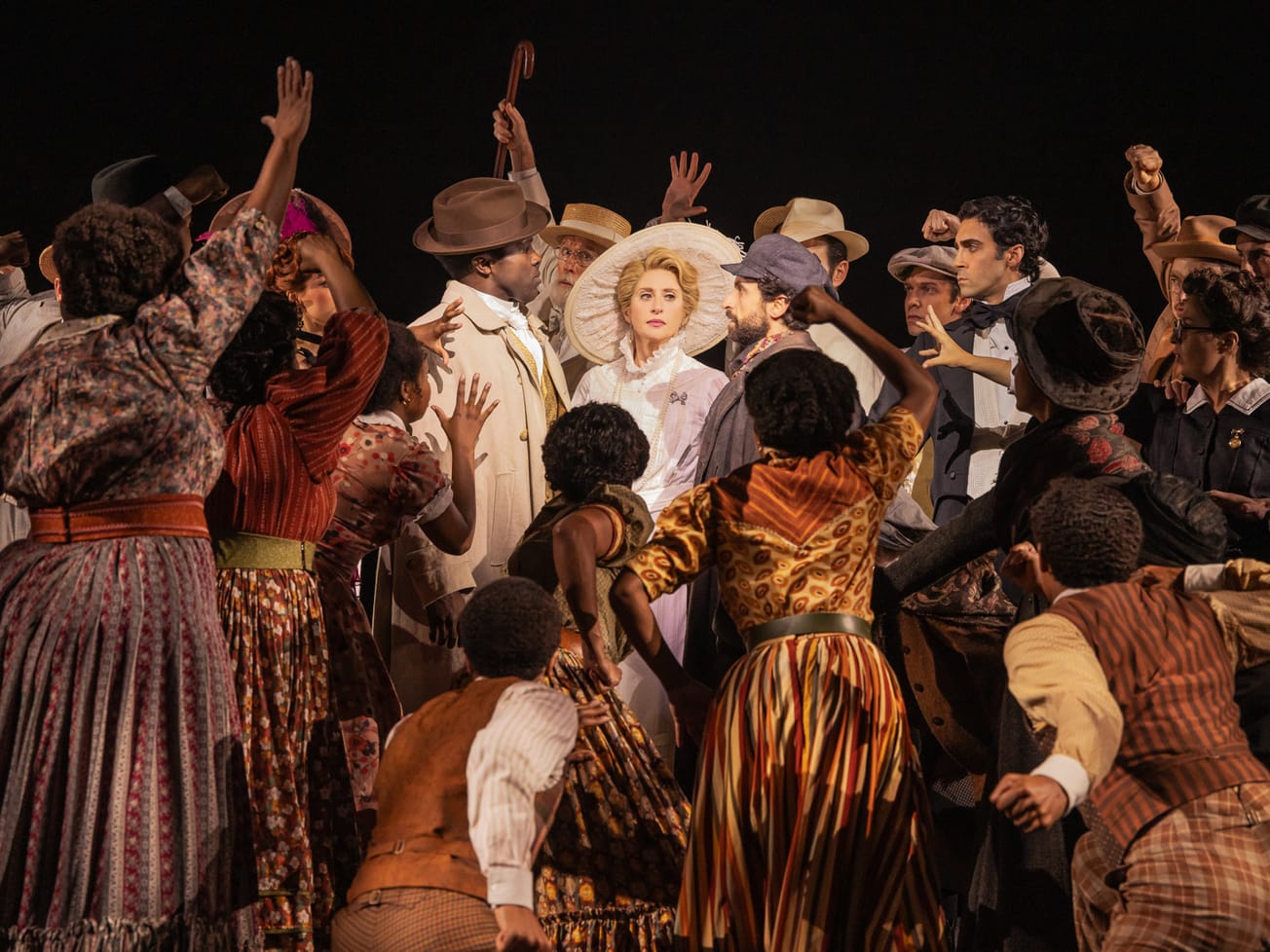This preview essay on Ragtime is published in collaboration with Lincoln Center Theater.
--
GRANDFATHER
Do you know any coon songs?
(COALHOUSE stops playing.)
COALHOUSE
Coon songs are made for minstrel shows. White men sing them in black face. This is called Ragtime.
(He resumes, now in earnest.)
YOUNGER BROTHER
Small, clear chords hung in the air like flowers. The melodies were like bouquets. There
seemed to be no other possibilities for life than those delineated by his music.
GRANDFATHER
Ill-tuned or not, the Aeolian had never made such sounds.
Music as the Melting Pot
That was the power of ragtime music. By 1910, immigration in New York City had been at an all-time high, clashing and blending cultures at the same time. In the musical Ragtime, Grandfather’s reaction and Coalhouse’s insistence are perfect examples of the future that would come. Despite the stereotypes white people held of the new immigrants calling New York home (and the marginalized ones that already lived there), it was music that joined a people. Music disrupted their biases, and it wasn’t just any form of music—it was ragtime. Ragtime is a musical style that peaked from the 1890s to 1910s. There are several theories about how ragtime got its name. For one, the musical style has a syncopated rhythm or a “ragged” rhythm that is usually performed on the piano. Another offering is that the music originated from Black enslaved plantation events known as “rags.” And just like the cakewalk, the juba, swing dancing, and other forms of Black music and dance that were born from clandestine cleverness, ragtime music was at the fringes of American music and culture, but soon grew to be a beloved pastime.
Ragtime grew in popularity because of musicians like Scott Joplin, Tom Turpin, James Scott, Eubie Blake, and later, Jelly Roll Morton who were based in the Midwest and the South. The music eventually traveled up to the East Coast. In New York, ragtime took center stage in Manhattan, specifically in an area known as The Tenderloin. The Tenderloin was a red-light district bustling with major theaters and restaurants. The Tenderloin occupied 24th to 57th Street. As early as the 1870s, African Americans occupied part of the Tenderloin, too. Before Harlem, African Americans owned several clubs downtown. Historian Brenda Dixon Gottschild cites businesses such as Joe Stewart’s Criterion, Ike Hines’s Club, and Barron D. Wilkins’s Little Savoy as popular venues. The Marshall and the Maceo were also two Black-owned hotels in the area. White and Black people alike enjoyed the growing grooves of ragtime throughout The Tenderloin. Entertainment venues downtown were also less likely to segregate due to the rise of Black musicals like 1903’s In Dahomey (music by Will Marion Cook, book by Jesse A. Shipp, and lyrics by Paul Laurence Dunbar) and 1907’s The Shoo-Fly Regiment (music by J. Rosamond Johnson; book by Bob Cole; lyrics by James W. Johnson). Furthermore, segregation prohibited African Americans in white venues, but whites were permitted in Black-owned businesses. According to musicologist Edward A. Berlin, other Black entertainment venues that featured ragtime were Sam Moran’s at 26th Street and Seventh Avenue, William Banks’s Café and Restaurant at 206 West 37th Street, Walter Herbert’s Café at 331 West 39th Street, and, the renowned, Café Wilkins at 253 West 35th Street, operated by Barron Wilkins. Despite several police raids, Wilkins continued to run his business until he and other business owners moved to Harlem with the changing landscape.
Building a Neighborhood, Building a Legacy
We begin the musical Ragtime in 1902 and we’re taken through to 1915. While the musical covers so much history in New York City at the time from immigration to class to police brutality, there’s a city bustling from scratch in the background that goes unseen. During this period, Harlem was in the midst of transformation. The first ragtime song published by an African American was “Harlem Rag” by Tom Turpin in 1987 (though it was already written in 1892 by the time of its filing). “Harlem Rag” is a signifier of Harlem’s rich history. Despite Harlem being a destination for wealthy white New Yorkers looking for summer homes in the 19th century, African Americans were already living in Harlem as early as 1880. However, it took drastic economic and political shifts to see the concentrated population of Black people in Harlem in the coming century.
The African American migration to Harlem was two-fold: Firstly, they were forced to relocate in 1904 when construction on the original Penn Station began. Secondly, the real estate market crash of 1904 left real estate agents unable to find white renters. Philip A. Payton, a Black real estate broker, shaped Harlem to be the Black mecca we know it as now. His company, the Afro-American Realty Co., led the Black residential boom in Harlem, leading Black New Yorkers to vacant properties. Between the Great Migration and the burgeoning Harlem Renaissance, which both budded in the 1910s, Harlem became a cultural hub.
With Black people moving to Harlem, ragtime traveled uptown with them, too. Hines’s Professional Club at 118 West 27th Street soon occupied new addresses at 235 West 135th Street and 23 West 134th Street. Wilkins’ brother, Leroy Wilkins, established a new cabaret for Black people in Harlem at 135th Street and 5th Avenue. There were other architects whose handiwork perfectly captured a changing New York at the turn of the century. Ragtime, the musical, mentions Stanford White early on. White was a prolific American architect and a partner in the architectural firm McKim, Mead & White (formed with Charles Follen McKim and William Rutherford Mead). From the Washington Square Arch to the Cable Building to St. Paul Apostle Church, White and his firm have been foundational to this city. Ironically, White and his firm helmed the original Penn Station, which began construction in 1904 and was completed in 1910.
Even theater is touched by his contributions. White designed The Players, a social club for artists that holds a repository of theater artifacts and hosts notable theater events in New York. The firm’s fingerprint can be found in Harlem as well. Amid Harlem’s changing landscape, the community insisted on a library uptown. Charles McKim designed the 135th Street Public Library, a landmarked, limestone building in 1905. The original building features an Italian Renaissance-style palazzo. In 1925, the New York Public Library opened the Division of Negro Literature, History, and Prints, which is what we now regard as the renowned Schomburg Center for Research in Black Culture. White’s footprint can be cherished throughout Ragtime: New York’s original underground (and later elevated subway system) that the citizens traveled out of, was likely run by the Interborough Rapid Transit Company Powerhouse (IRT). White and his firm designed the IRT Powerhouse in 1901; there’s also the historical Morgan Library, a major scene towards the end of the play. White and his firm designed the library in 1902.
White architects weren’t the only ones shaping New York—Black architects designed buildings in Harlem, too. Vertner Tandy and George Foster, two Black architects, opened their firm, Tandy & Foster, and grew in popularity across the state. Tandy was the first registered African-American architect in New York State. In 1911, Vertner Tandy designed St. Philip’s Episcopal Church—the oldest Black Episcopal parish in the city. In 1923, George Foster designed Mother African Methodist Episcopal Zion Church. These buildings weren’t just religious havens, they were community centers disseminating information and providing necessary social services.
The Brick Keeps the Score
As the ‘20s roared on, the lines between ragtime and jazz blurred. The term “ragtime” faded, and jazz became a new catchall phrase for the still rugged music. The Cotton Club, The Savoy Ballroom, and Minton’s Playhouse were popular venues during the Harlem Renaissance. Many historic buildings have long been demolished or repurposed. However, the famous Apollo Theater is a great example of a building that’s endured New York’s changing cultural landscape. The theatre originally opened in 1913 for white patrons only, but by 1934 it was acquired by Sidney Cohen, and it became a venue for Black performers. Today, it’s part of a larger cultural uptown revival with the expansion at Harlem’s Victoria Theater (which has a different architect and developer from the hotel which is housed at the same location).
Today, other historic Harlem venues that have hosted iconic talents like Bessie Smith and Billie Holiday have grown decrepit due to neglect and mismanagement. The Alhambra Ballroom, a famous vaudeville venue built in 1905, was a foundational site during the Harlem Renaissance. Unfortunately, from the 1920s to the 2000s, the building remained closed and has weathered rugged financial situations. (I remember going bowling at the now-gone Harlem Lanes for the first time and oh! the fun I had!) But today, the stunning Alhambra operates with a more scaled-back operation, sharing space with a much-needed neighborhood supermarket and other businesses. Other historic Harlem establishments like The National Black Theater, the longest-running Black theater in New York City, are also undergoing renovations. The founder, Dr. Barbara Ann Teer purchased the original building in 1969. The newly renovated building is set to open in 2027 and is designed by Frida Escobedo Architects in collaboration with Handel Architects and Marvel Architects. This is one of the few buildings in Harlem built by women, particularly by women of color.
While ragtime has since faded, its roots can be felt in jazz, hip-hop, R&B, funk, and the blues. The breadth of the music can be heard downtown at sites such as The Village Vanguard and Blue Note; or uptown at Bill’s Place and Harlem Nights. Many of Harlem’s historic venues are now mixed-use— housing entertainment, apartments, retail, food, and hospitality spaces all in one building. That’s a good thing, as we, collectively, are all calling for more third spaces in our community. Whether they were located downtown or downtown, those renowned venues were always so much more than a place to perform—they were home.
Ragtime is playing now at LCT through January 4th, 2026.
Photo by Matthew Murphy.






